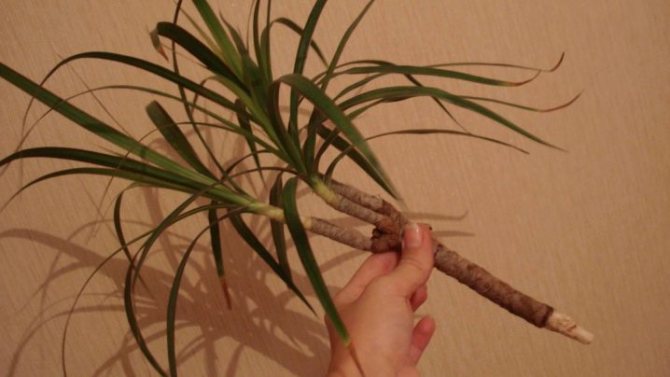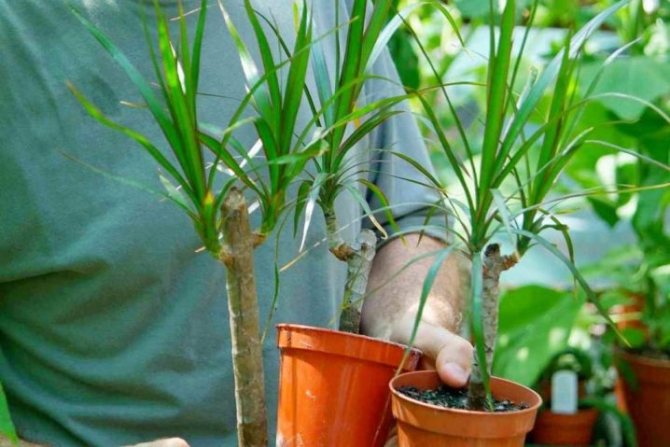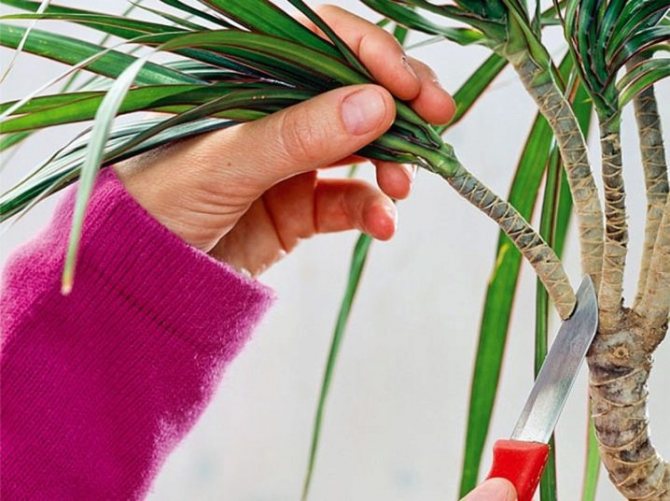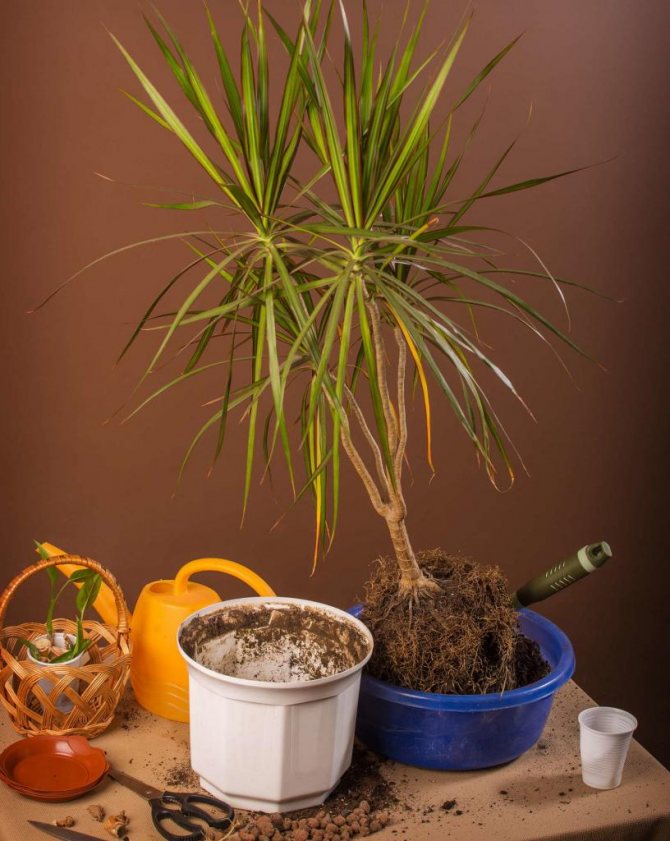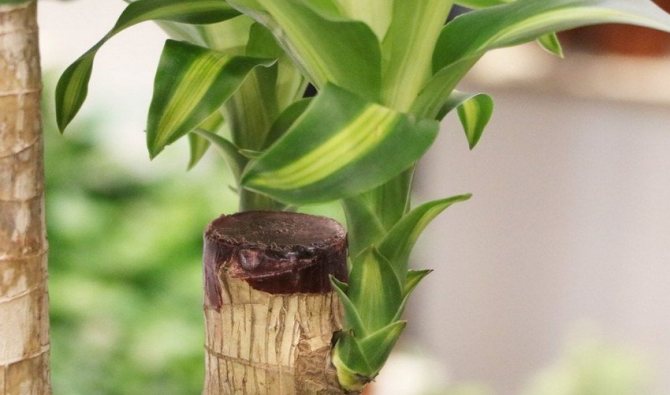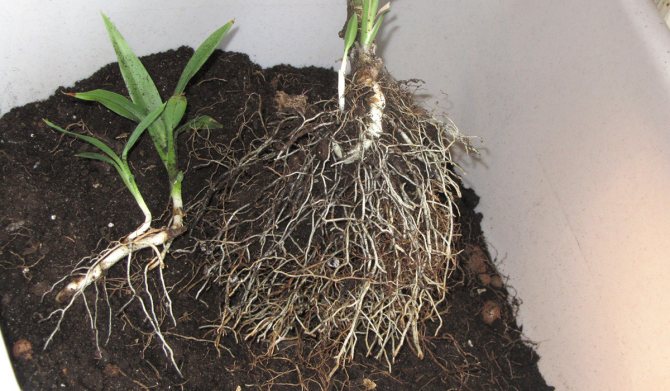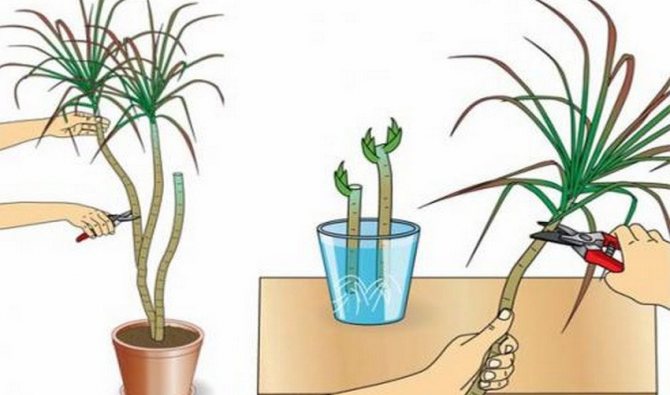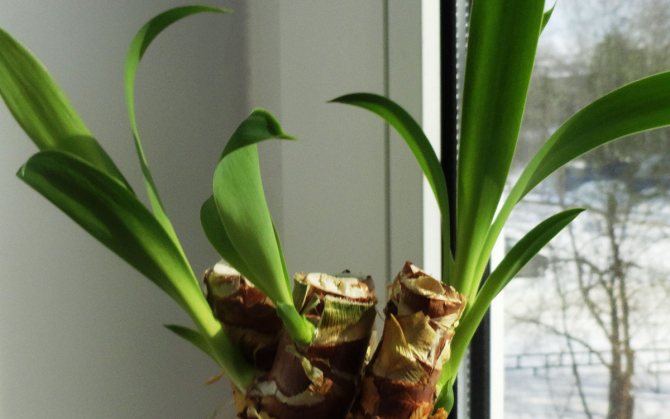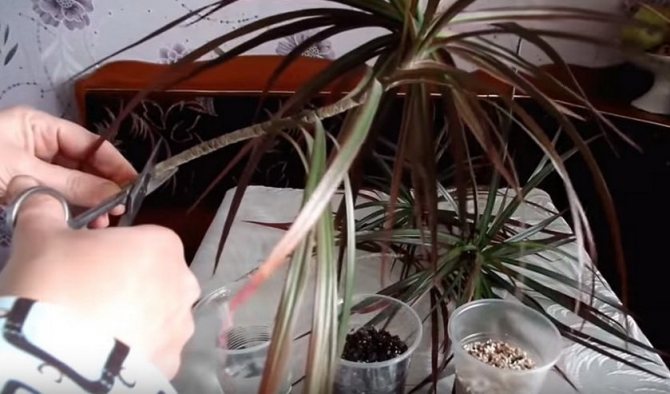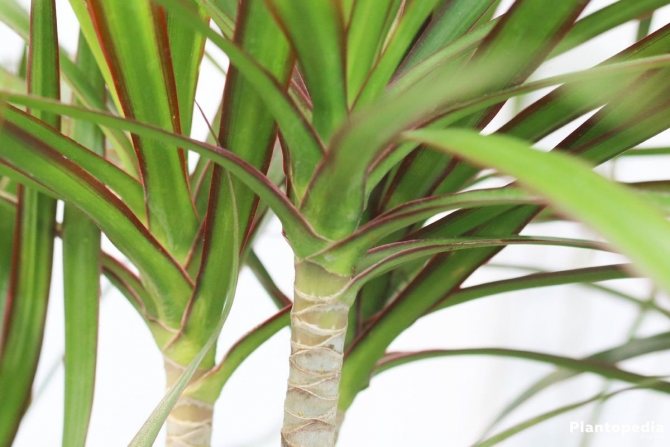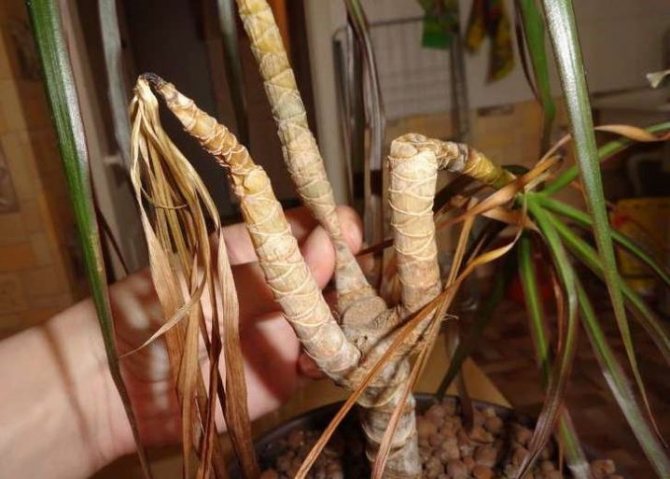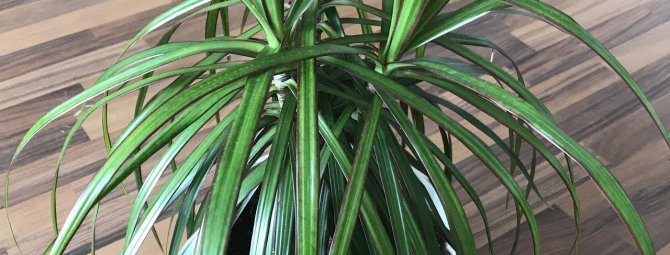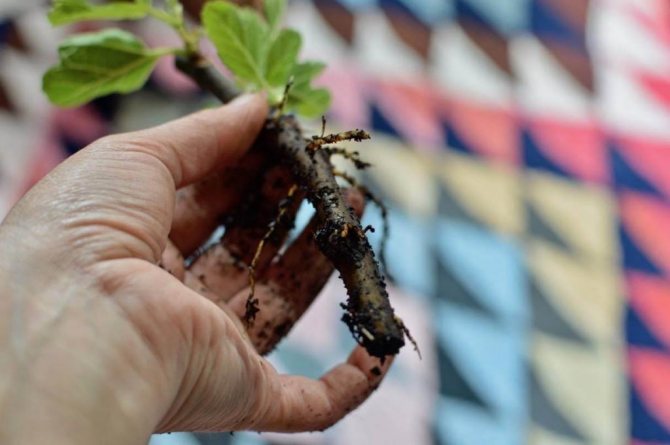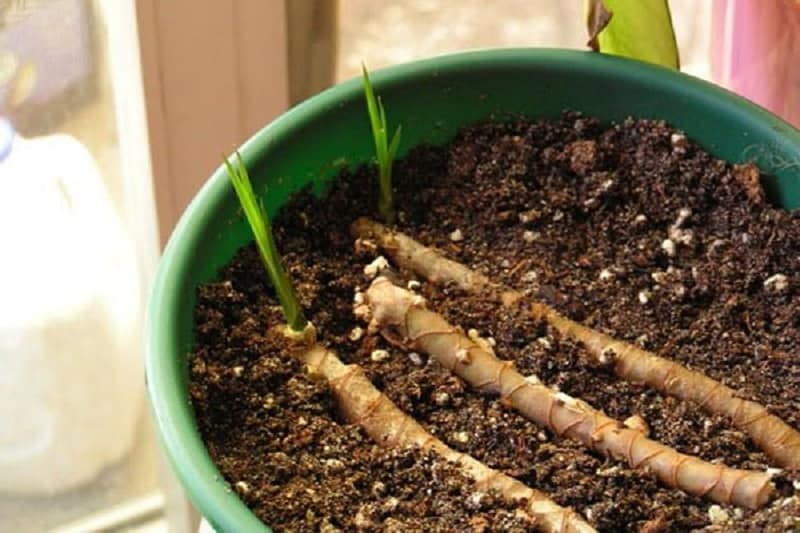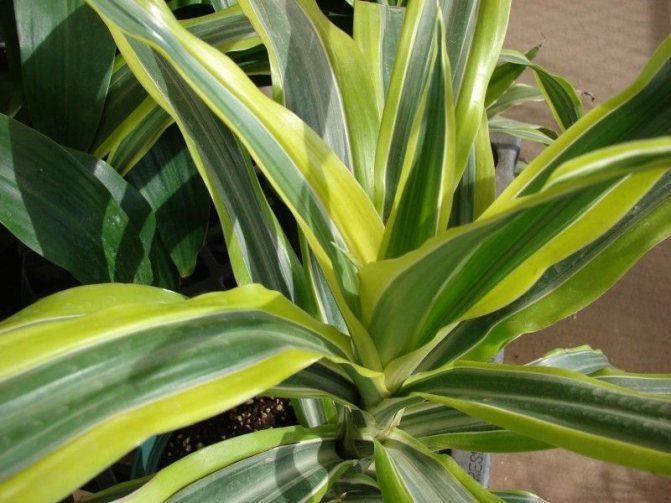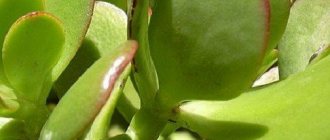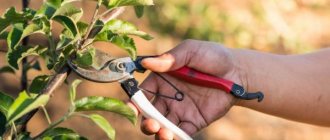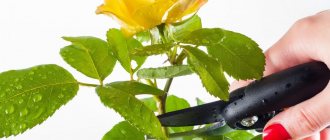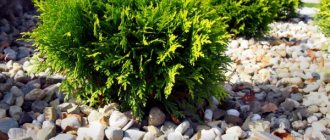Many women would like to know how to breed dracaena. Indeed, in this way, they could get several plants instead of one. This article will discuss how to propagate dracaena at home, videos and photos will be attached. You can successfully apply the information obtained in practice.

The need for pruning
Currently, several main reasons are well known for which the cutting of an indoor ornamental plant is vital:
- in order to preserve the compactness of the room dracaena;
- in order to maintain the most attractive appearance;
- for sanitary purposes.


If the false indoor palm tree has grown too high, almost to the ceiling, then a breakdown of the trunk is often observed, and primary pruning is used to reduce the risk of this phenomenon.... In indoor floriculture conditions, strong stretching of the plant should not be allowed, therefore, the scapula is carried out when a height of 0.3-0.4 m is reached. The stem part is cut at the required height, which allows maintaining compactness and attractive appearance. A broken plant also needs to be pruned correctly.
If the already branched houseplant has grown strongly or has become insufficiently decorative, with ugly growing shoots, then the dracaena will need formative pruning. Sick a plant with dry or decaying shoots undergoes immediate sanitary pruning, which involves the removal of all diseased parts. Despite the fact that after sanitary pruning, in most cases, the plant is capable of losing its external attractiveness for a long time, such an event allows you to preserve the ornamental culture and achieve branching of lateral shoots.
Basic rules for growing dracaena
Dracaena does well both in shaded areas and in well-lit areas, but keep in mind that a culture with variegated leaves retains its uniqueness in a lit room, while a flower with green leaves does better in partial shade.
Dracaena does not grow very well with frequent and abundant watering, while it favors spraying the crown (especially in winter, when the air becomes dry due to heating).
The temperature regime of the room where the culture grows should have the following indicators: in winter from + 15 ° C to + 18 ° C, in summer from + 20 ° C to + 26 ° C.
Did you know? In the Middle Ages juice drheumatoid dracaena was widely used as a medicine and varnish for wood. In particular, the famous master Stradivari used it to create his legendary violins.
To rejuvenate the plant or its breeding, it is necessary to cut the crop in a timely manner.
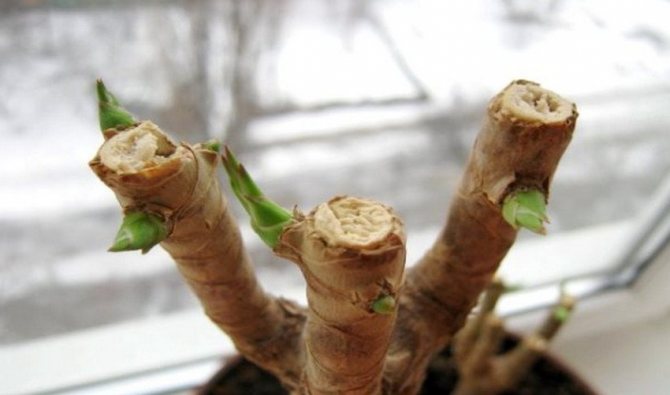

Features of the
In flower shops and flower nurseries, dracaena with ready-made branches are sold, since when growing, at the initial stage of development of a young plant, a bush is formed in greenhouse conditions. Most often, the plant does not have one top and consists of two or three well-formed shoots.
After purchasing dracaena, amateur flower growers have a great opportunity to form the crown of a decorative culture on their own.It should be noted that crown formation and pinching is possible only if there is a completely healthy and well-developed plant. A grown indoor palm must be formed not only regularly, but also as correctly as possible. Only in this case the ornamental plant will look well-groomed and beautiful.
All deformed shoots should be cut off without fail, as a result, the plant releases new shoots and a large amount of foliage is obtained, and the indoor flower takes on new, attractive forms. Any above-ground areas affected by pests or diseases must be cut off immediately after detection. It is in this way to exclude mass infection.
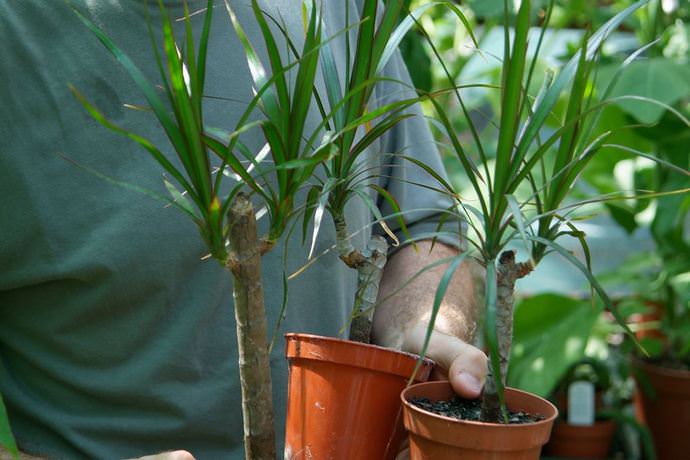

Dracaena cuttings and rooting
Dracaena is cut in two main ways - tops and parts of the stem. Cuttings are rooted in water, inert materials, soil. Conventionally, propagation of dracaena by hemp remaining after cardinal pruning of the plant can be attributed to cuttings.
Propagation by apical cuttings
This is the most common method of vegetative propagation.
For propagation by apical cuttings:
- choose the top without dead leaves, signs of disease and damage by insect pests, the apical processes remaining after pruning the mother plant are also suitable;
- with a sharp disinfected knife, cut off the crown with a bunch of leaves of a semi- or completely lignified stem 15-20 cm long;
- remove the lower leaves;
- the stalk is left to dry for half an hour;
- the cut is powdered with charcoal powder;
- at the lower thick end of the branch, a small vertical cut is carefully made, into which a small pebble is inserted to accelerate the formation of the root system.
Dracaena cuttings can be rooted in water.
The easiest way is to root the dracaena in water. To do this, the process is immersed in boiled water at room temperature, poured into a glass of dark glass, one centimeter. Install in a well-lit place, but protected from direct rays of the sun. Maintain a constant water temperature of + 18-22 ° C.
To prevent rotting of the lower part of the appendix and disinfect water, an activated carbon tablet is used. In the glass, as it evaporates, add warm, settled water.
When phytohormones (stimulants) are added, the water often becomes cloudy. In this case, it is completely changed 2-3 times a week.
Dracaena cuttings are prone to decay. If the bark begins to peel off the appendix, on the part submerged in water, it is cut just above the place of decay, dried a little and again immersed in warm disinfected water.
The first roots usually hatch after 2-3 weeks. After 1.5-3 months, the young dracaena can be transplanted into a permanent pot.
Rooting of the apex directly into the ground is also possible. Using this simple technology, the sections are dried in the open air, covered with growth powder or soaked for several hours in a solution of a root formation stimulator (Kornevin, Heteroauxin), and then planted in slightly moistened sand or soil.
The seedling is covered with a film or placed in a mini-greenhouse. The little house is regularly ventilated. The first time the seedling is watered after 10-15 days, then as the soil dries. At a constant air temperature of + 23-25 ° C and heating of the soil, the cutting takes root in 1-2 months.
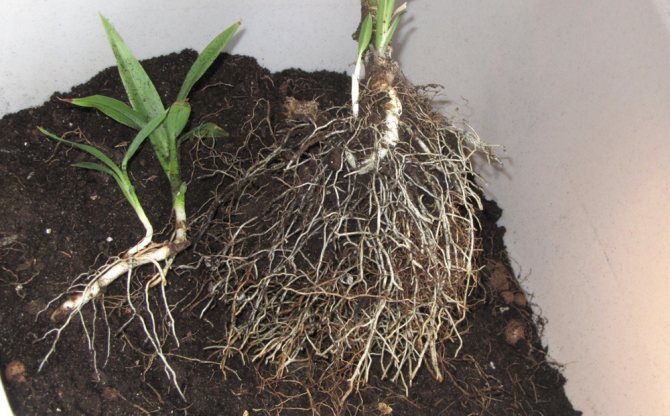

When rooting dracaena in the ground, the cuttings give roots in a couple of weeks.
Propagation by stem cuttings
For reproduction in segments, strong young stems are chosen or the bare trunk of an old plant is used. Young shoots are cut into pieces 4-20 cm long, the trunk into cuttings at least 7 cm. Each cuttings should have from 2 to 5 buds. It is desirable that the cut passes along the sheet scar. For ease of processing, the upper cut is made straight, the lower one - at an angle.
When pruning a large plant, leafy parts of the trunk with 1-2 nodes and a leaf are used. At the same time, the sheet is cut by one third or half.
The harvested shoots are dried, the upper cut is covered with garden varnish, plasticine or paraffin is poured over, the lower one is sprinkled first with coal powder, and then with Kornevin. On the lower part of the cuttings, one incision is made in the bark, on the large processes there are several incisions. The cuttings are now ready for rooting.
With the "dry" method of propagation, cuttings are planted in:
- sand;
- a mixture of peat, sand, sod land in equal proportions;
- ready-made soil for dracaena, palm trees, cordilina with the addition of washed and calcined river sand;
- a mixture of peat and sand;
- inert materials (vermiculite, perlite, hydrogel).
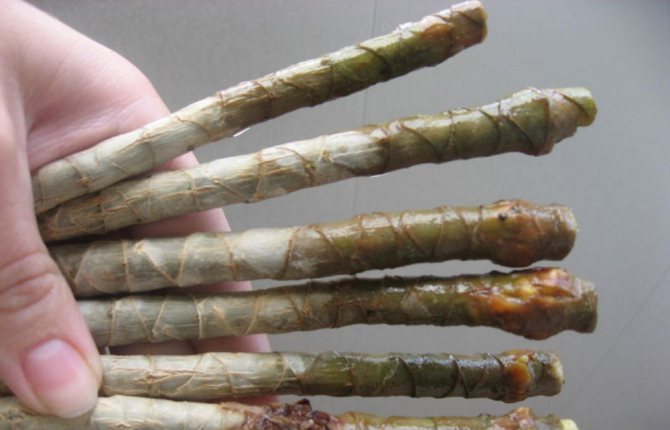

In the photo, cuttings of dracaena, cut and prepared for rooting.
Any substrate, except for the hydrogel, is preliminarily disinfected with a weak solution of potassium permanganate. At the bottom of the container, drainage must be done. When rooting, expanded clay is poured into sandy, peat, soil mixtures. When planting in inert materials, sphagnum is placed on the bottom.
Stem cuttings are rooted horizontally and vertically. With the traditional vertical method, the process is buried with a lower cut into a wet substrate by 2-3 cm.
Rooting the cuttings horizontally, they are laid on a moistened substrate, pressed a little. If it is necessary to root parts of a thick stem, it is cut in half lengthwise, the cut is dried, treated with charcoal and stimulants, the cutting is laid with the cut down on the substrate.
If the seedlings are provided with comfortable greenhouse conditions, in 1-1.7 months they will be ready for transplantation.
Important. Rooting with stem cuttings occurs faster, in addition to the roots, lateral shoots also appear on the shoot.
Propagation by air layers
The method is used quite rarely.
To obtain planting material:
- choose a place on the apical or bare part of the plant;
- a circular incision 1 cm wide is made under the sheet (knot);
- the bark is removed at the incision site, the wound surface is treated with any phytohormone or stimulant;
- Dracaena is rarely propagated by air layers.
below the incision, a plastic wrap is fixed, so that a "pocket" is formed in which slightly moistened peat or sphagnum is laid;
- The "pocket" is tightly sealed above the incision, and if the substrate inside begins to dry out, it is carefully moistened with a syringe;
- after a new root system is formed in the package, the air cut is cut and rooted in the soil or inert material;
- the place of the cut on the mother plant is sealed with paraffin or garden varnish.
Hemp propagation
Without resorting to cuttings, a new dracaena can be grown from an old hemp. The method is applicable, for example, to accidentally broken plants.
For hemp propagation:
- the trunk is cut at the desired height or below the scrap level;
- the cut is treated with pitch or paraffin;
- all leaves below the cut level by 10-15 cm are removed;
- the stump is covered with a plastic bag, regularly ventilated, watered, maintaining the optimal temperature and lighting.
Important: The method is not entirely reliable. The plant often dies or gives new lateral shoots after quite a long time. Sometimes you have to wait a year or more for the result.
Pruning time
The trunk of the indoor dracaena is a well-developed aerial part of the ornamental culture, the structural feature of which is the spiral arrangement of dormant buds. It is thanks to this that, in indoor floriculture conditions, it is possible to obtain seedlings or rudiments for the formation of new branches on cuts made in almost any stem part of the plant.
Planned pruning of dracaena is most often carried out during the period of active growth of an ornamental plantwhen the movement of plant juices is in the best way. Sometimes it becomes necessary to form a bush on an emergency basis. As a rule, this situation occurs when the stem part breaks off. In this case, the plant must be pruned below the scrap site. It is important to note that any kind of pruning can only be as effective as possible on an absolutely healthy ornamental crop.
Light mode
Dracaena is a light-loving plant. In the winter season, she simply "suffocates" from lack of sunlight. She needs artificial lighting. At other times, the palm should be protected from the hot rays of the spring and summer sun.
Advice: "In the room, pots with this flower should occupy the eastern or western windowsills, places close to the windows."
Can be placed in the southern zone, providing diffused lighting.


How to prune a dracaena for branching
For branching of indoor dracaena, use standard pruning technique. Performing the primary pruning of tall dracaena, using a sharp and clean knife, the upper part of the plant is cut off, after which the cut section is necessarily treated with paraffin. The cut plant should be placed in partial shade, and adhere to a temperature regime of 24-25 ° C. In this case, one should not expect too rapid branching of room dracaena. As a rule, lateral shoots begin to grow actively no earlier than three months after the implementation of the event aimed at branching the stem of the culture.
If the ornamental plant was pruned earlier, but after this procedure it managed to stretch out strongly, then it will be necessary to perform the formative pruning again. In this case, neatly, but as evenly as possible, all the tops of the already elongated shoots are cut off, after which the branches are shortened by cutting at a distance of 20-30 cm from the stem part.
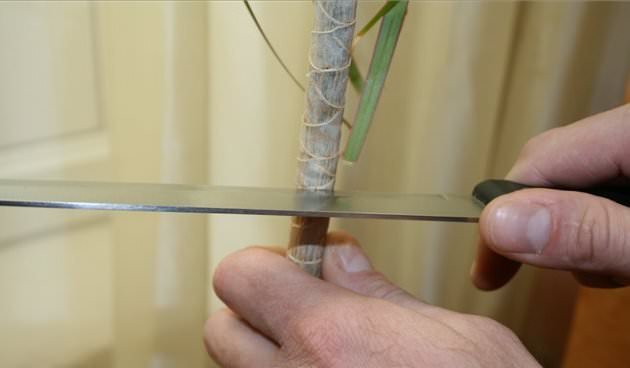

All too deformed above-ground areas that are not suitable for crown formation will also have to be subject to mandatory removal. Shortening shoots at different heights gives a good visual effect. In any case, all sections obtained as a result of crown formation must be filled with paraffin. It is allowed to sprinkle the sections of the cuts with crushed charcoal or cover with a special wax for processing the cuts, and then treat with the drug "Zircon", which very well stimulates the branching process.
Types of dracaena and methods of reproduction
For a long time, there were heated debates in scientific circles about the belonging of the dracaena to this or that family. It was attributed to agave, then to liliaceae, singled out as a separate family of dracaena. In the end, botanists came to a common opinion and ranked the dracaena in the Asparagaceae family.


At home, Canarian and edged dracaena are more often grown.
In the wild, dracaena is widespread in Africa, South America, India, the Mediterranean, and the Canary Islands. About 160 plant species are described, including huge trees, small shrubs, and dwarf plants, but no more than 15 species are usually used as indoor or greenhouse plants.
And the most popular are:
- Dragon (Canary) Dracaena, reaching a height of up to 1.5 meters at home. The dragon tree has a thick, dense trunk. At the ends of the branches and at the top, leathery, elongated, dark green leaves, shimmering red in the light.
- Marginata (bordered). Reaches a three-meter height. It is valued for its long (up to 80 cm), narrow green leaves with a spectacular brown, yellow or red border.
- Fraranas, which is often called fragrant for its distinct, pleasant smell of fresh hay.
- Sandera (bamboo spiral) - an unusual plant with trunks resembling knotty bamboo stems, narrow variegated or monochromatic leaves twisted into a spiral.
Other dracaena are no less spectacular - bent, tree-like, dracaena Godsphere and Hooker.
Almost all dracaena that are grown at home can be easily propagated by seeds and vegetatively - with apical and stem cuttings, air layers, part or stump of the trunk. Dracaena can be rooted both in water and in soil.
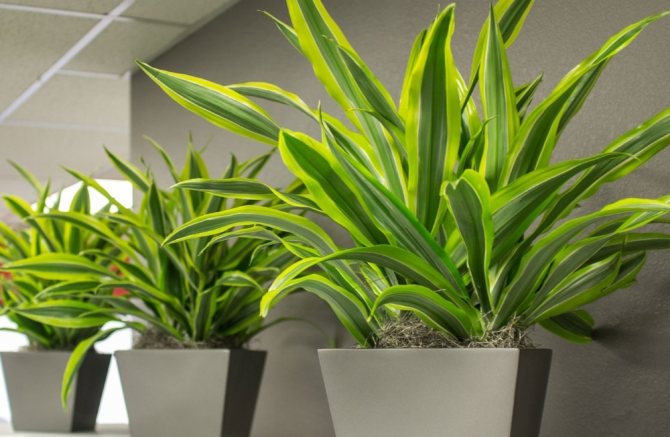

At home, dracaena is propagated by cuttings, layering and in other ways.
Important: The optimal breeding time in any chosen way is early spring. It is during this period that the plant enters a phase of active growth.
How to use dracaena cut pieces
All trimmed parts can be planted by rooting in a nutrient medium or water. Additionally, you can process the cuttings of the harvested dracaena cuttings "Kornevin". In order for the rooting of the planting material to be as easy and fast as possible, the pot with the rooted plant must be covered with a plastic bag, which will help to create an optimal temperature regime and high humidity. The appearance of new leaves indicates the readiness of the plant for transplantation to a permanent place.


Propagation of dracaena seeds
Many varieties of room dracaena multiply by seeds, the only exception is sandera, which is bred vegetatively. It is not recommended to breed fragrant dracaena and some other variegated varieties with seeds that do not retain varietal characteristics during seed propagation.
The seed planting algorithm is quite traditional for indoor crops:
- Seeds are sown from December to March. Winter landing is preferable. Seedlings from seeds planted in winter have time to get stronger by spring - the most favorable period for transplanting.
- Granular (pelleted), inlaid, laser (plasma) seeds, which have undergone special treatment before implementation, are sown without additional preparation. Untreated seeds are pre-soaked in a diluted stimulant (Epin, Zircon) and left for a day in a room with a temperature of + 28-30 ° C. Seeds harvested directly from the plant are peeled and processed in the same way as seeds from bags.
- The prepared planting material is sown in seedling boxes or mini-greenhouses with bottom heating.
- The first shoots from seeds appear within 1-2 months.
For sowing, use ready-made soil (Dracaena, Cordilina, Palma) or prepare it yourself from commensurate parts of sod land, river sand and humus.
- In a room with seedlings (or in a greenhouse), a constant temperature of + 25-27 ° C is maintained. The ground, and then the seedlings, are regularly sprayed with warm water, the boxes are ventilated.
- Seeds germinate 30-60 days after planting.
- When the seedlings reach a height of 5-7 cm, they are transplanted into pots and placed in a well-lit place with a temperature of + 21-25 ° C.
Important The seed method is used when breeding rare dracaena, when breeding new varieties. This method is complex, rarely leading to the desired result.
Further care
If you prune the dracaena in violation of the technology, then the fleshy stem of the ornamental plant begins to dry, but it is equally important to provide the indoor culture with proper care after the formation of the aboveground part. After pruning, a tropical plant for good growth and full development must be provided with sufficient lighting, spraying and high-quality irrigation measures.
Quite often, after pruning, the dracaena forms several buds at once, but as a result, some die, while others stop growing and development. Despite the fact that the indoor false palm tree grows rather slowly, providing proper conditions of detention and competent care, an amateur florist can achieve a plant height of one and a half meters or more. To activate growth processes, you will need not only the presence of sunlight and warm humid air, but also regular fertilizing with complex fertilizers.
Air layering
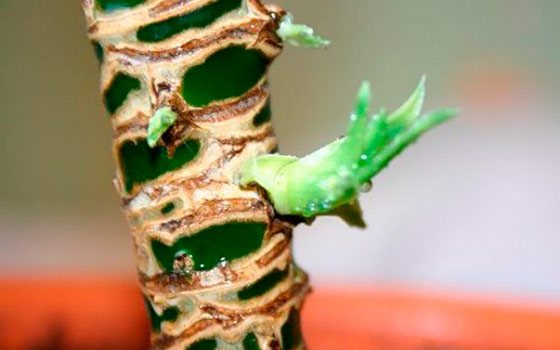

This method is used when the dracaena is small in size, and there is no way to propagate it in another way. This process should be considered step by step.
- A transverse incision is made on the trunk, under the place where the sheet used to be. Its depth should be approximately to the middle of the stem.
- A chip or toothpick is inserted into the incision, which will prevent it from overgrowing.
- The area around the incision is lined with moss and wrapped in cellophane.
- To prevent sphagnum from drying out, it must be periodically moistened with a sprayer.
- When roots grow through the moss layer, the film is removed and the grown shoot is cut off from the trunk.
- The resulting seedling is rooted in ordinary soil for dracaena. For the best result, it is advisable to place it in a greenhouse or simply cover it with a large jar for several weeks.
If everything is done correctly, then such a shoot will grow into a full-fledged plant much faster than with the first two methods.
Dracaena: crop results (video)
A good result is also given by additional stimulation of the growth of lateral shoots by spraying with a solution of urea, diluted at the rate of one gram of the drug per liter of warm and settled water. Nitrogen-containing fertilizers are very well absorbed by indoor plants through the foliage. Horn shavings or bone meal can be added to the potting soil during planting. With proper care in indoor floriculture, regardless of the type, dracaena eventually grows into a very decorative and large specimen of indoor culture.
What problems can arise
Dracaena is an unpretentious culture, but there are several rules, the observance of which will help keep the flower beautiful and healthy, will not lead to its premature death:
- moderate watering, the soil should be slightly moist. The flower easily tolerates drought;
- when transplanting a flower, use only new (disposable) pots. The use of used containers increases the likelihood of contracting any infection;
- wean the flower from the greenhouse in time.
Important! Dracaena is a succulent plant. Excessive watering can lead to its death.
Dracaena is a versatile decorative flower that will be appropriate in any room, creating a unique atmosphere. By giving the plant its original shape, you can further emphasize its tropical origin and enjoy the exotic look for many years.
Reproduction by apical cuttings (crown)
Prepare a sharply sharpened knife - the cut on the handle should be even, without chipping and jamming. When using pruning shears or scissors, the cut point is crushed, crumpled, and this leads to rotting of the cutting. So let's get started.
- Cut off the top with the stem, leaving a stump about 8 cm high.
- If the stem of the cutting is covered with leaves, remove the excess, leaving them only on the crown.
- With a sufficiently large length of the cut stem, we shorten it from the crown to a height of 15 cm.
- Set aside the rest, you will also use it later for grafting.
- Dry the cut site for half an hour.
- Prepare a container in which you will root the cutting.
- Pour clean water at room temperature into it. Throw an activated charcoal tablet on the bottom (so that the water does not deteriorate longer). You can add a couple of drops of a drug that accelerates the formation of roots (for example, Zircon).
- Place the stalk in the water. Keep it clean, change it if it becomes cloudy.
- When the roots appear (about two months later), plant the seedlings in a pot.
- Take a small pot. Place sphagnum moss on the bottom.
- Top with vermiculite, or perlite, or sand, or a mixture of sand and peat.
- Pour a slightly pink solution of potassium permanganate.
- Moisten the bottom of the cutting with water and dip in any powdered root stimulant (for example, Kornevin or Heteroauxin).
- Place the finished top into the substrate to a depth of about two cm. Gently tie the leaves into a bundle (for less moisture evaporation).
- Make sure that the soil in the container does not dry out, but do not flood it either.
- Spray the leaves with a spray bottle in the morning and evening.
- It is possible, but not necessary, to make a mini - greenhouse by putting a plastic bag or half of a plastic bottle on top of the pot.
- The regrowth of young leaves is a signal that rooting was successful.
Using stem cuttings
After you are done with the top, work on the rest of the stem.
- If it is long enough, use a knife to divide it into cuttings about 5 cm long. Cut strictly along the scars - the places where the leaves were attached. Each segment should have at least two buds.
- Split the bottom cut a little with a knife (very carefully), this contributes to faster root formation.
- Plant the cuttings in a pot with the split end down. Pre-treat it with any rooting stimulant.
- Place the stem section horizontally in the pot.
- Press the lower end lightly into the ground. Do not cover the cutting itself with the substrate.
- Maintain the temperature in the apartment at about twenty-five degrees Celsius.
- Further care - as described above.
- The regrowth of leaves is a sign of the appearance of roots.
Step-by-step instructions for transplanting Dracaena
To get a healthy and viable plant as a result of transplanting, follow the following algorithm:
- We water the dracaena abundantly one day before the transplant.
- Choose a pot of the right size.
- Pour drainage (expanded clay or small pebbles) at the bottom of the prepared pot.
- We fill in a thin layer of earth. We moisturize slightly.
- We water the dracaena one day before the transplant.
- Carefully remove it from the old container by tapping or cutting the container.
- We clean the roots from the ground, trying not to injure them. We cut off the decayed roots.
- Moisten the roots.
- We put the dracaena in the center of the pot, add earth, shaking the plant and slightly tamping it.
- The soil should cover all the roots of the dracaena and be about 3 cm below the edge of the container, the root collar should be at the level of the soil.
- Water the plant abundantly.
- We add earth if the roots are bare.
- Can be covered with drainage or moss.
Rooted dracaena cuttings are planted in a similar way, excluding root washing. If the cutting was rooted in the ground, then the earthen lump can be saved.
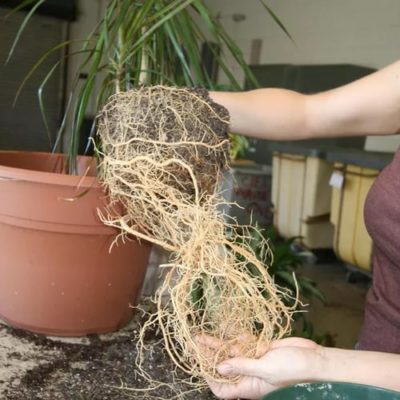

During transplantation of dracaena, it is necessary to cut off excess roots and remove their rotten parts.
Transplant process
Dracaena can be successfully transplanted, even if you have little experience of a florist. The main requirement is caution and delicacy, the roots of the false palm are very delicate. Before starting work, prepare everything you need: settled water, pruning shears. Be sure to disinfect the secateurs: lubricate the tool with alcohol or ignite its tip over a fire.
At home, it is correct to carry out a transplant as follows.
- Place the drainage layer in the flowerpot. Its height cannot exceed 3 cm.
- Remove the dracaena from the old container.
- Remove all soil above the roots of the plant; it should be partially preserved between the roots.
- Examine the root system carefully. If you notice rotten or dryish roots, remove them immediately. Determine by eye whether the underground part is large - if it is large relative to the upper one, carefully trim the roots. Shorten those that bulge. Sprinkle all cuts for drying with ash.
- On top of the drainage in a new pot, put a little of the finished substrate, immediately compact it.
- Place the plant in the center of the container. Spread the roots evenly over the pot. Planting depth remains the same.
- Pour the soil into the container, shake the pot a little, this is done to avoid the formation of voids. Compact the ground carefully.
- The plant must be watered abundantly, the leaves must be sprayed.
- When the soil has settled, add some more substrate to the pot.
- Take a clean (new) damp sponge, gently remove the dirt from the palm tree itself and the pot.
- After half an hour, drain the excess liquid from the pan.
Step by step recommendations
In order not to make the plant only worse or not to destroy it, you must clearly follow the step-by-step instructions during pruning.
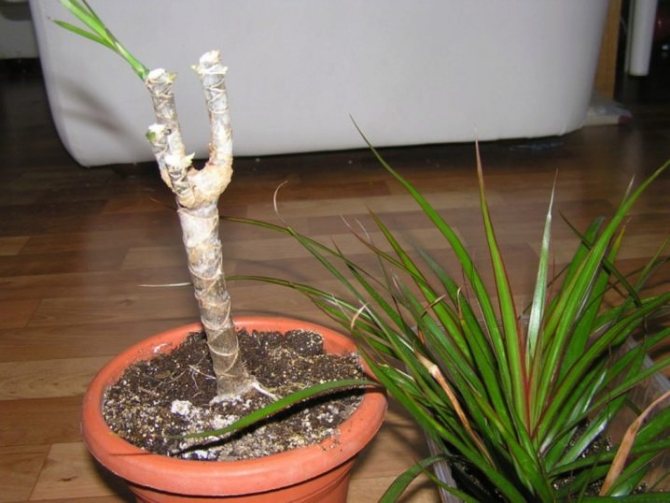

To begin with, we take an alcoholized instrument for this. First you need to determine the height where the cut will be made, while it is strictly forbidden for it to be below an area of 30 cm... The future slice should be located at such a level that there is easy access to light. Then, with a sharp disinfected knife, carefully and accurately make an incision in the place where the mark was made.
It is impossible to break shoots under any circumstances... The juice that appears at the place where the cut is made is removed with a cotton pad. Then this area must be treated with garden varnish, crushed activated carbon or molten paraffin. It is better not to use wax, so as not to harm the flower.... This is to prevent the barrel from drying out.
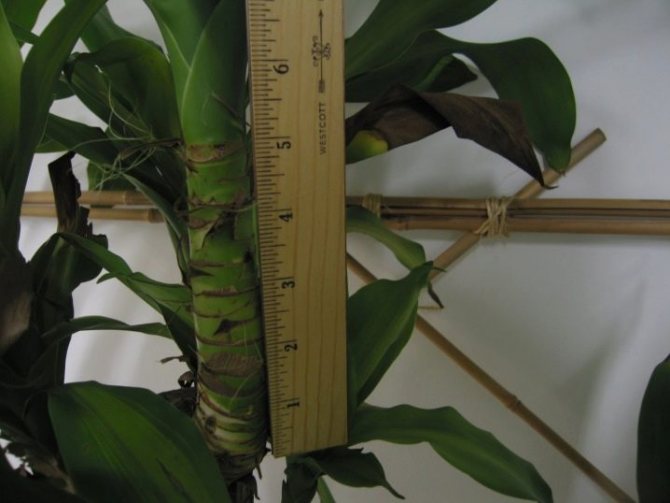

In the event that foliage is located at a distance of 10 cm or more, it should be removed to minimize the evaporation area and rapid germination of sprouts.
To awaken the kidney formation on the trunk, it is recommended to treat it with a growth stimulant. An aqueous solution of biological growth stimulants is well suited.


Next, you need to wrap the trunk slightly below the cut with moistened peat moss and leave the cut open. Then put on a regular plastic bag or cling film to maintain the desired humidity and temperature. Then wrap the incision with peat moss.
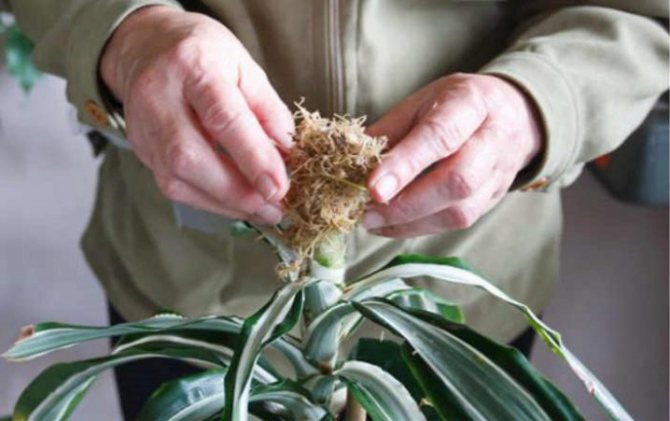

The next month, new shoots will form on the trunk, but before they appear, you need to clean the greenhouse at least once every 5 daysto water and ventilate the plant, and then we remove it in a dark, cool room.


In the event that you have a young dracaena with one trunk, with a good height, not less than 30 cm to the leaves, then you have the opportunity to prune it to obtain lateral shoots for branching. To do this, you need to cut about 10 cm from the top of the flower. After that, a certain number of shoots should form.
It is recommended to keep only the three strongest shoots so that they have more room for further growth.
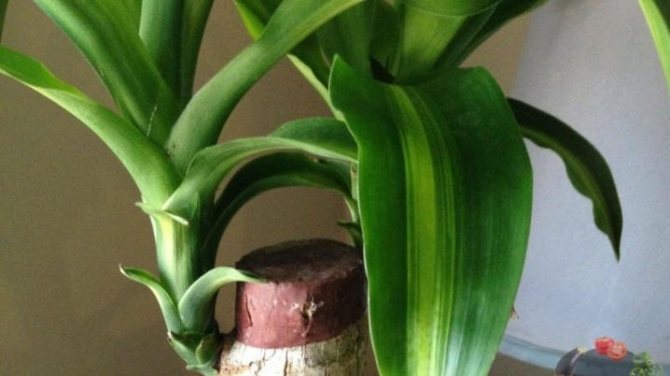

If pruning is done at home, certain rules must be followed. They will differ depending on the goal you have set: you will form a beautiful crown, you want to rejuvenate a flower or carry out sanitary procedures.


In order to cut a branch for a branch, a standard technique is used. At the first operation using a knife, the apex is cut off. Then it is necessary to treat the cut site with paraffin, after which the plant is placed in a dark and cool place. The temperature should not exceed +25 degrees... And for the plant to start branching, it will take a long time.
The flower will not sprout at once. This will take at least three months.
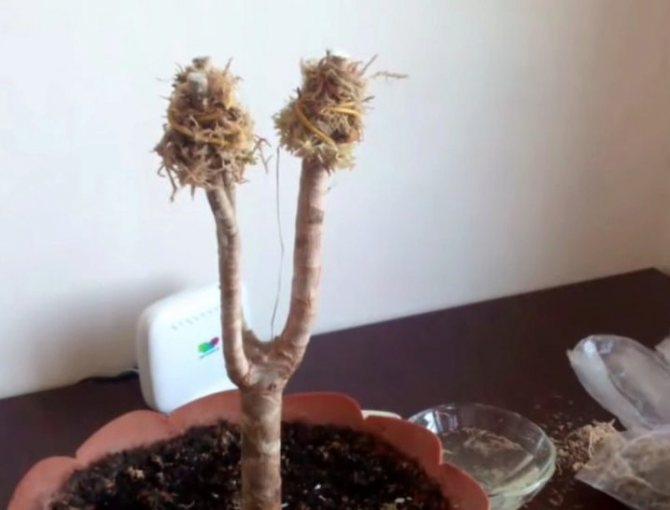

If you have already had experience with pruning dracaena, but many trunks have already grown, you will have to carry out this operation again. Cut the upper part of the crown at the same level. And we also remove damaged leaves, they will not make an attractive crown. In order to get a flower in several tiers, it is possible to trim the shoots at different heights.
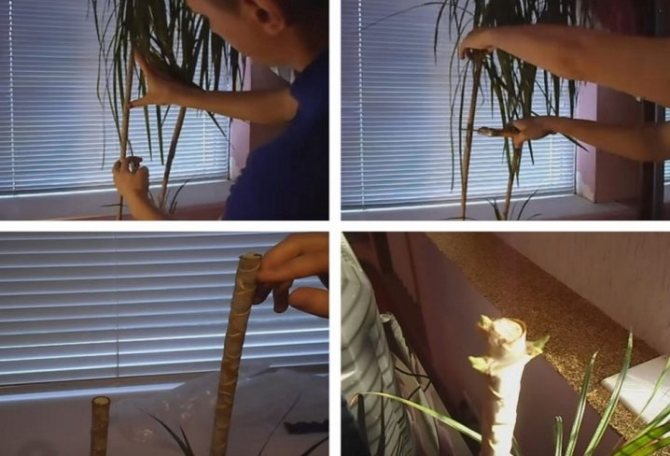

When pruning for sanitary-prophylactic procedures, only wounded, broken and diseased parts of the plant are removed.
Basically, such difficulties arise due to inappropriate care: too abundant watering, dry and cold air. Such errors are instantly displayed on the plant, it begins to lose color, the leaves dry up and fall off. In the process, the trunk is exposed, and the dracaena loses its beautiful appearance.
After the plant has been treated with antifungal agents, it is possible to cut it only after 10 days. This is done in order to stop the disease and remove damaged areas.
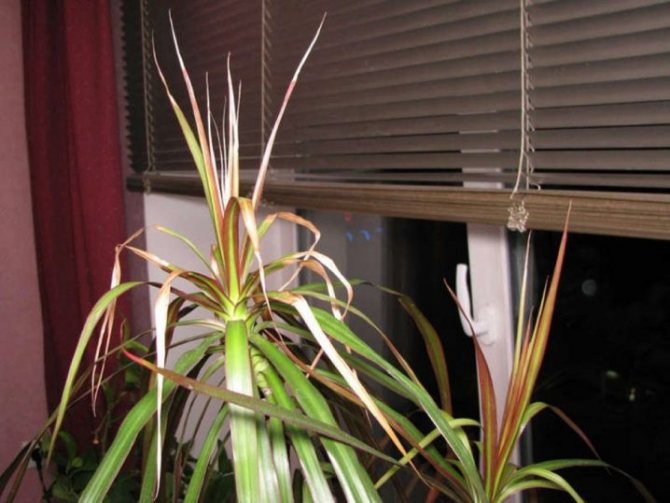

How to choose a pot?
The root system of the dracaena is characterized by inward development, since it has almost no lateral processes. Therefore, the capacity should be high and relatively narrow - if there is a shortage of space for root development, the plant will die. If you notice that the plant has been transplanted relatively recently, but there is not enough room for the roots, it needs another pot.
The specific dimensions of the pot are correlated with the size of the dracaena. For example, if it is about 40 cm in height, then the diameter of the container should be about 20 cm. Buying flowerpots "for growth" is not the best solution: the roots may not take root in a large volume of soil, because of this, moisture stagnation, rotting, a flower will begin will die.
There must be drainage holes in the pot, if you purchased a flowerpot without them, you will have to drill them yourself in any convenient way. But if it is not difficult to do this in a plastic container, such manipulations cannot be done with a ceramic product. Therefore, even when buying, pay attention to the presence of drainage.
The material of the new pot depends only on your taste and finances; dracaena takes root in both simple plastic and expensive ceramics. However, the second option is more environmentally friendly.
FAQ
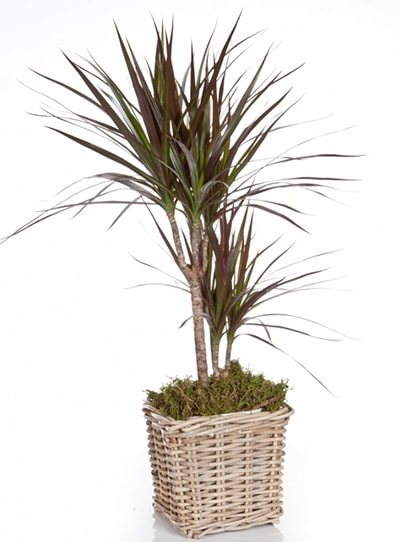

On flower forums, novice florists often ask questions. For example, - "Why are the leaves of young shoots too light?"... A possible cause would be a lack of nutrients in the soil. It is necessary to feed the seedlings with a solution of fertilizer for palm trees.
Some flower lovers are looking for alternative ways to breed Dracaena. You can root the shoots in a floral sponge or raw potatoes. In addition to moisture, potatoes will also provide nutrients to the cuttings.
"Why doesn't he want to grow for a long time when transplanting a cuttings into a pot?"... Answering this question, we can say that, most likely, the pot is chosen too large in volume. Until the roots have mastered the pot, the ground part will not grow.
Thus, knowing some secrets, the reproduction of dracaena will not present much difficulty and will be available even to a novice gardener. A little time and effort - and now there is not one plant in the house, but several young ones who will soon turn into adult handsome men.
When is the best time to transplant?
Experts believe that if the tree is young (up to five years old), then it needs to be replanted every year. Large dracaena is transplanted every three years. On average, the plant is provided with a new "home" every two years.
But if the dracaena develops well and there is enough space in the container, you should not bother her. Even the most gentle transplant is a stressful moment, because the root part is still injured.
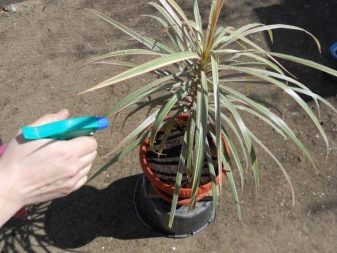

You cannot do without a transplant if:
- dracaena really "grew" out of a pot or container, the roots overcome the drainage structures and, having gathered in loops, line the bottom;
- dracaena has been in the same container for more than three years, the growth is zero, the leaves turn yellow profusely;
- the plant is freshly acquired, it is in a container with soil for transportation;
- soil acidification is noticeable due to excess moisture, there is a risk of root rot (midges usually fly over the affected flower, and it is easy to notice parasites in the ground).
If you have just brought a plant from the store, then it makes sense to wait for the beginning of spring - in March and April, a young flower will take root better in fresh soil. It was at this time that the dracaena begins to grow vigorously, releases fresh leaves.
The possible transplanting time is the entire growing season. Dracaena is able to settle in a new flowerpot in spring, summer and autumn (at the beginning). In winter, she is rarely disturbed. If you bought the plant in November or December, wait until spring. A shoot taken from the side also takes root better in the soil in spring, the cuttings are more viable at this time.
If it is not possible to postpone the transplant until the appropriate season, carefully follow the instructions, create ideal conditions for the plant for the adaptation period. There are no other secrets - only competent transplantation and careful care will help the tree survive the "resettlement" less traumatically.


Useful Tips
Only in case of severe illness can the plant be trimmed in any season of the year. It is important to cut off absolutely all damaged areas of the flower: trunk, foliage, branches. And also very it is imperative to inspect the condition of the roots... In the event that the roots are partially affected, then they are also pruned and disinfected.
If the roots are all affected, you can try to save the good parts of the flower for further cultivation. The cut off upper parts of the trunk, if they are in order, will then be transplanted, but first it is necessary to lower it for preventive purposes in a solution of potassium permanganate for 6 hours.
Irrigation regime and air humidity
In order for the plant to fully develop, it needs competent watering. The abundance of this procedure depends on factors such as:
- seasonality;
- container size;
- soil condition;
- location.
Now we will more specifically consider the mode of watering dracaena when planting at home. Even a novice florist can handle this procedure and subsequent care.


In the summer and spring, the watering regime is once every two days. If the leaves of the flower are drooping, watering is worth more often. If the container is large, you will need more water for irrigation; for a small pot, take a little water. For the comfortable development of an exotic flower, high air humidity is important. Dracaena actively responds to a water shower. And he prefers to take it regularly.
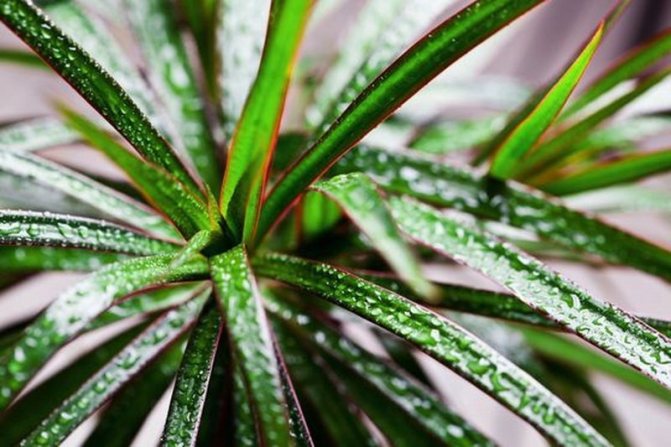

Suitable soil
There are two scenarios for further actions: buy a ready-made substrate or make it yourself. If it is decided to purchase the soil in a special store, then the soil for indoor palms or large non-flowering plants will be preferable. False palms, which include dracaena, take root well in a moderately nutritious, airtight substrate, neutral or slightly acidic. It should not contain a lot of peat and baking powder.
When preparing your substrate, be guided by proven recipes:
- 2 parts of sod soil + 1 part of leafy soil +1 part of compost soil + 0.5 peat;
- universal soil for indoor plants (1 share) + garden soil (0.5 share) + chopped moss (0.1 share);
- 2 shares of sod land + 1 share of deciduous land + 0.5 shares of coarse sand;
- 2 shares of humus + 1 share of sand + 1 share of leafy soil;
- equal parts of deciduous humus, sod soil, greenhouse humus, 0.5 share of river sand.
The soil will also like the addition of crushed red brick or charcoal chips. Coal is a well-known protector of soil from rotting, and the properties of red brick can be attributed to the strengthening of the looseness of the soil, the absorption of excess moisture. Loves a tree and coconut fiber, the briquette of which should be soaked before adding.
You can take brick chips as a drainage layer, pebbles, polystyrene, vermiculite or expanded clay are also suitable.



